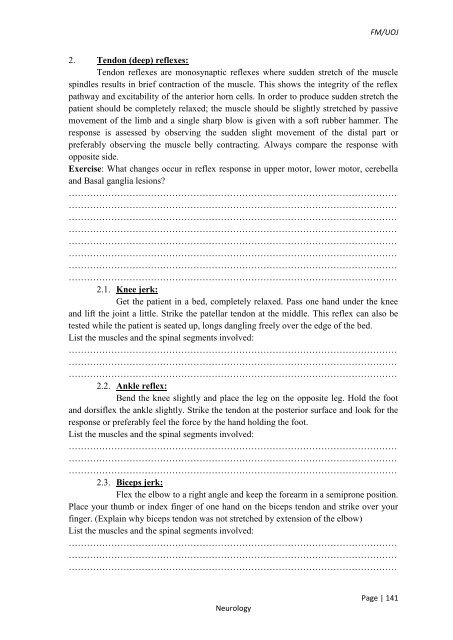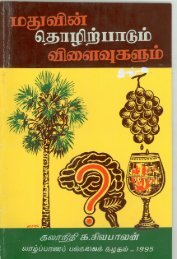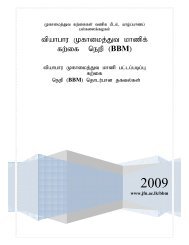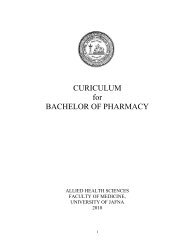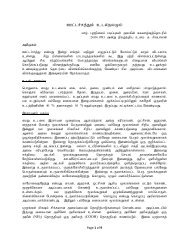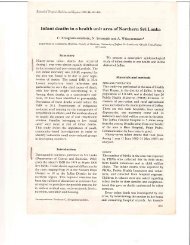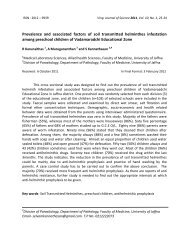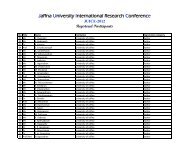MANUAL PHYSIOLOGY PRACTICAL - Repository:The Medical ...
MANUAL PHYSIOLOGY PRACTICAL - Repository:The Medical ...
MANUAL PHYSIOLOGY PRACTICAL - Repository:The Medical ...
You also want an ePaper? Increase the reach of your titles
YUMPU automatically turns print PDFs into web optimized ePapers that Google loves.
FM/UOJ<br />
2. Tendon (deep) reflexes:<br />
Tendon reflexes are monosynaptic reflexes where sudden stretch of the muscle<br />
spindles results in brief contraction of the muscle. This shows the integrity of the reflex<br />
pathway and excitability of the anterior horn cells. In order to produce sudden stretch the<br />
patient should be completely relaxed; the muscle should be slightly stretched by passive<br />
movement of the limb and a single sharp blow is given with a soft rubber hammer. <strong>The</strong><br />
response is assessed by observing the sudden slight movement of the distal part or<br />
preferably observing the muscle belly contracting. Always compare the response with<br />
opposite side.<br />
Exercise: What changes occur in reflex response in upper motor, lower motor, cerebella<br />
and Basal ganglia lesions?<br />
………………………………………………………………………………………………<br />
………………………………………………………………………………………………<br />
………………………………………………………………………………………………<br />
………………………………………………………………………………………………<br />
………………………………………………………………………………………………<br />
………………………………………………………………………………………………<br />
………………………………………………………………………………………………<br />
………………………………………………………………………………………………<br />
2.1. Knee jerk:<br />
Get the patient in a bed, completely relaxed. Pass one hand under the knee<br />
and lift the joint a little. Strike the patellar tendon at the middle. This reflex can also be<br />
tested while the patient is seated up, longs dangling freely over the edge of the bed.<br />
List the muscles and the spinal segments involved:<br />
………………………………………………………………………………………………<br />
………………………………………………………………………………………………<br />
………………………………………………………………………………………………<br />
2.2. Ankle reflex:<br />
Bend the knee slightly and place the leg on the opposite leg. Hold the foot<br />
and dorsiflex the ankle slightly. Strike the tendon at the posterior surface and look for the<br />
response or preferably feel the force by the hand holding the foot.<br />
List the muscles and the spinal segments involved:<br />
………………………………………………………………………………………………<br />
………………………………………………………………………………………………<br />
………………………………………………………………………………………………<br />
2.3. Biceps jerk:<br />
Flex the elbow to a right angle and keep the forearm in a semiprone position.<br />
Place your thumb or index finger of one hand on the biceps tendon and strike over your<br />
finger. (Explain why biceps tendon was not stretched by extension of the elbow)<br />
List the muscles and the spinal segments involved:<br />
………………………………………………………………………………………………<br />
………………………………………………………………………………………………<br />
………………………………………………………………………………………………<br />
Neurology<br />
Page | 141


